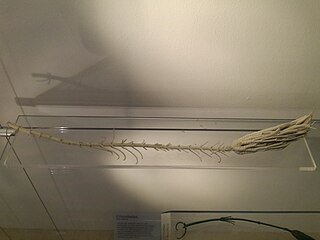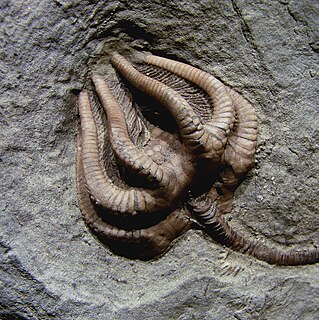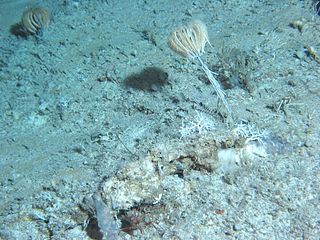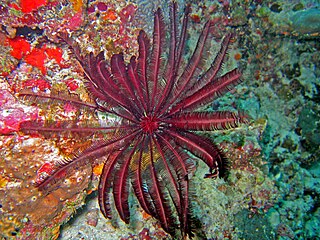Related Research Articles

An echinoderm is any member of the phylum Echinodermata of marine animals. The adults are recognizable by their radial symmetry, and include starfish, sea urchins, sand dollars, and sea cucumbers, as well as the sea lilies or "stone lilies". Adult echinoderms are found on the sea bed at every ocean depth, from the intertidal zone to the abyssal zone. The phylum contains about 7000 living species, making it the second-largest grouping of deuterostomes, after the chordates. Echinoderms are the largest phylum that has no freshwater or terrestrial members.

Caenorhabditis elegans is a free-living transparent nematode about 1 mm in length that lives in temperate soil environments. It is the type species of its genus. The name is a blend of the Greek caeno- (recent), rhabditis (rod-like) and Latin elegans (elegant). In 1900, Maupas initially named it Rhabditides elegans. Osche placed it in the subgenus Caenorhabditis in 1952, and in 1955, Dougherty raised Caenorhabditis to the status of genus.

Crinoids are marine animals that make up the class Crinoidea, one of the classes of the phylum Echinodermata, which also includes the starfish, brittle stars, sea urchins and sea cucumbers. Those crinoids which, in their adult form, are attached to the sea bottom by a stalk are commonly called sea lilies, while the unstalked forms are called feather stars or comatulids, being members of the largest crinoid order, Comatulida.

Cryptomeria is a monotypic genus of conifer in the cypress family Cupressaceae, formerly belonging to the family Taxodiaceae. It includes only one species, Cryptomeria japonica. It used to be considered by some to be endemic to Japan, where it is known as Sugi. The tree is called Japanese cedar or Japanese redwood in English. It has been extensively introduced and cultivated for wood production on the Azores.
A. elegans may refer to:

Protobothrops elegans is a venomous pitviper species endemic to Japan in the southern Ryukyu Islands. No subspecies are currently recognized. Common names include: elegant pitviper, Sakishima habu (サキシマハブ), and elegant tree viper.

Mutinus elegans, commonly known as the elegant stinkhorn, the dog stinkhorn, the headless stinkhorn, or the devil's dipstick, is a species of fungus in the Phallaceae (stinkhorn) family. A saprobic species, it is typically found growing on the ground singly or in small groups on woody debris or leaf litter, during summer and autumn in Japan, Europe, and eastern North America. The fruit body begins its development in an "egg" form, resembling somewhat a puffball partially submerged in the ground. As the fungus matures, a slender orange to pink colored stalk emerges that tapers evenly to a pointed tip. The stalk is covered with a foul-smelling slimy green spore mass on the upper third of its length. Flies and other insects feed upon the slime which contains the spores, assisting in their dispersal. Due to their repellent odor, mature specimens are not generally considered edible, although there are reports of the immature "eggs" being consumed. In the laboratory, Mutinus elegans has been shown to inhibit the growth of several microorganisms that can be pathogenic to humans.
S. elegans may refer to:

Allogalathea elegans is a species of squat lobster that is sometimes kept in marine aquariums. Despite their common name, they are more closely related to hermit crabs than lobsters.

Metacrinus rotundus, the Japanese sea lily, is a marine invertebrate, a species of stalked crinoid in the family Isselicrinidae. It is a species found off the west coast of Japan, and is living near the edge of the continental shelf, around 100–150m deep. This is the shallowest species among the extant stalked crinoids.

Agaricocrinus americanus, the mushroom crinoid, is a species of extinct crinoid, known only from its fossils, which are found in the U.S. states of Indiana, Tennessee and Kentucky. They date back to the Lower Mississippian, about 345 million years ago.

Bourgueticrinida is an order of crinoids that typically live deep in the ocean. Members of this order are attached to the seabed by a slender stalk and are known as sea lilies. While other groups of crinoids flourished during the Permian, bourgueticrinids along with other extant orders did not appear until the Triassic, following a mass extinction event in which nearly all crinoids died out.
Allopontonia brockii is a small commensal shrimp in the family Palaemonidae.

The Kimmswick Limestone is an Ordovician geologic formation in Arkansas, Illinois and Missouri. Fossils occurring in the Kimmswick include corals, bryozoans, brachiopods, conodonts, trilobites, crinoids and mollusks.
C. elegans most commonly refers to the model round worm Caenorhabditis elegans. It may also refer to any of the species below. They are listed, first in taxonomic order and, second, alphabetically.

Scyphocrinus, is an extinct genus of crinoids. Species belonging to this genus lived during the Silurian and Devonian periods.
Cicerocrinus is an extinct genus of crinoids in the family Pisocrinidae. It is known from the Silurian of the United Kingdom. The type locality for C. elegans is Old Bridge near Ludlow.

Endoxocrinus parrae is a species of stalked crinoids of the family Isselicrinidae. It is the most commonly found isocrinine species in west Atlantic Ocean.

Colobometridae is a family of crinoids belonging to the order Comatulida. Members of this order are known as feather stars.
References
- ↑ Gislén T (1922) The crinoids from Dr. S. Bock's expedition to Japan 1914. Nova Acta Regiae Societatis Scientiarum Upsaliensis (4)5(6), pages 1-183, text-fig. 1-162, pl. 1, 2